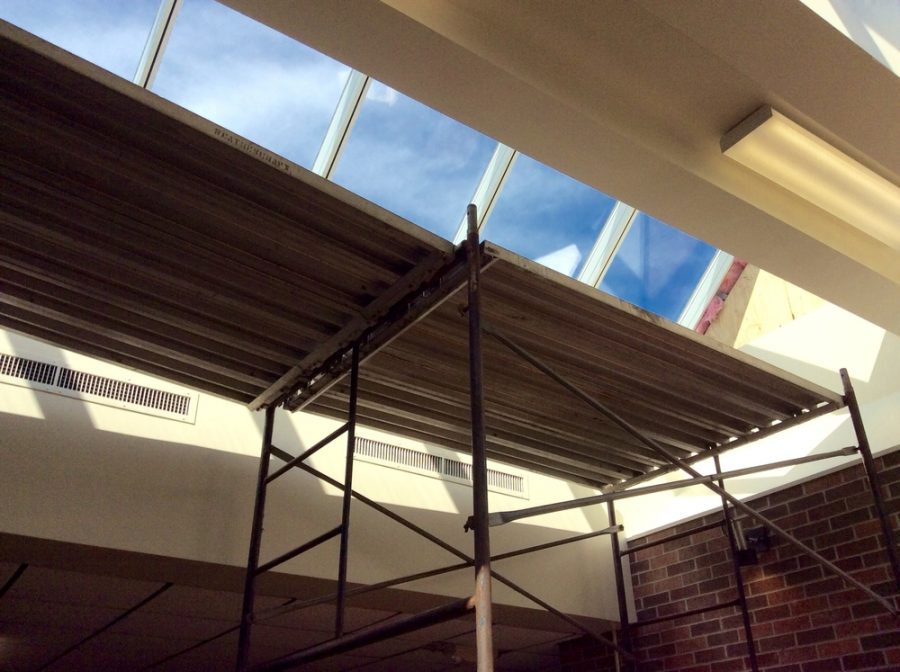RBHS stands firm in its ground as the 42-year-old building undergoes structural changes to the roof and skylights.
The school’s flat weathered roof is receiving a layer of synthetic rubber roofing, EPDM (ethylene propylene diene terpolymer), along with a new lining of insulation. In addition, skylights are being replaced to increase effectiveness in heating and cooling.
The project rings in at an estimated $1.2 billion and is expected to be completed by October 2015, assistant principal of building operations Brian Gaub said.
“About 60 percent of the roof is being redone in addition to the two sets of skylights in the main commons and the east atrium,” Gaub said. “The skylights are by far the most complicated part of the construction process.”
With double pane glass replacing original single pane windows, the new and improved skylights hope to achieve greater efficiency through the hollow of gas confined by the two panes. Typically filled with argon or krypton, the gas acts as insulation which blocks off unwanted noise, heat and cold.
“In the wintertime, the heat escapes through single pane glass better than it will through a modern [double] pane,” Gaub said. “This building, the very front east main entrance, are all still single pane glass just because they’re 40 years old, and it’s very expensive to replace— but they will eventually be replaced.”
Since the erection of RBHS in 1973, parts of the building have undermined with time, as was the case with the 42-year-old roof. Additionally, during the month of June, rain showers caused leakage and rain damage to roofs and walls, impeding school construction.
“This was just the worst summer to be doing a roofing project because it rained constantly,” Gaub said. “Sometimes they would take off the old roof and the rain would pop up, damaging ceiling tiles and sheet rock, so it really has been difficult. The weather makes a difference and because of it, [contractors] are behind.”
The overall contractor for the roofing project is Weathercraft, a company of 100 years based in Jefferson City, Mo. Further subcontractors under Weathercraft include a North Carolina window manufacturing company, along with Vac-It-All Services, Inc. based in St. Louis, Mo., whose roofers specialize in removing rock ballast from building rooftops.
“Basically, [roofers] have a vacuum cleaner the size of a semi truck up on the roof, vacuuming up the rocks,” Gaub said. “That’s what some of the horrible sound is — when that rock goes into that hopper.”
In addition to the progressing wide-scale project, several side projects were completed over the summer to improve functionality of school campus, Gaub said.
The North parking lot was resurfaced and repainted and stadium lights were altered from six lights to four lights per mount. Concrete poles were drilled 16 feet into the ground and wooden light posts were displaced with metal posts.
While changes are being made for the overall betterment of RBHS, school wide construction is looked down on as it interferes with school hours, imposing distractions and inconvenience among students and staff.
“The street in the south parking lot gets really crowded and the traffic gets even worse because of the construction they are doing,” sophomore Yash Pal Khanna said. “The loud noises from whatever they’re doing up there is distracting and annoying when you’re trying to talk to someone.”
However, reconstructional projects have advantages greater than energy efficiency alone because ultimately, a well maintained building is a well maintained preservation for the legacy of Bruins.
“[Construction] doesn’t impact me personally and it probably wouldn’t affect a student directly, but the school benefits as a whole,” Khanna said. “Because we know that we’re in a safe environment with a secure roof over our heads.”
By Joy Park
Featured photo by Joy Park
Categories:
RBHS reconstruction to roof, skylights
September 22, 2015
0
More to Discover













































































